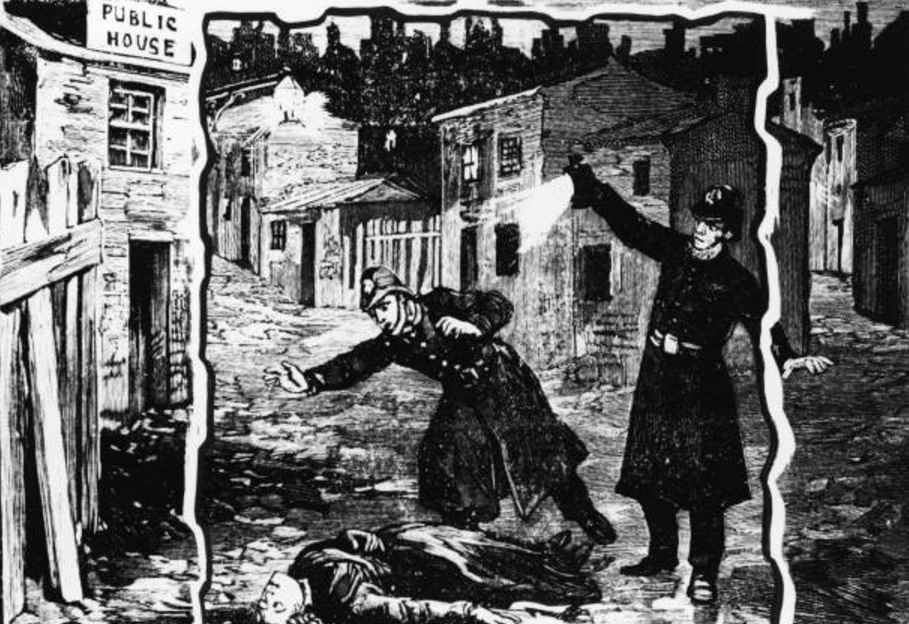Uncover the chilling tale of Jack the Ripper, the notorious killer who haunted Victorian London, leaving a legacy of mystery and terror.
“Don’t feel like reading? Immerse yourself in the chilling tale through our audiobook version of this blog—just hit play and let the story unfold!” 👇👇👇
Crime stories have always intrigued the human mind, but few cases remain as infamous and haunting as that of Jack the Ripper. This mysterious figure left a trail of horror in the slums of Victorian London in 1888. Even today, the identity of the killer is shrouded in mystery, fueling countless theories and debates. Let’s dive into the chilling details of the case, exploring the lives of the victims, the investigation, and the possible suspects behind one of history’s most notorious crime sprees.

The Gruesome Backdrop of Whitechapel
In the late 19th century, London’s East End neighborhood of Whitechapel was a grim place to live. Overcrowded streets were home to the city’s poorest residents, with poverty driving many to desperate measures. Women, especially, faced dire circumstances, with many turning to prostitution to survive. Amidst this bleak environment, Jack the Ripper began his reign of terror, targeting vulnerable women and shocking the world with his brutality.
The Victims of Jack the Ripper
Mary Ann Nichols (Polly)
The first known victim, Mary Ann Nichols, was found brutally murdered on August 31, 1888. She was 44, struggling with alcoholism, and had turned to prostitution to make ends meet. On the night of her death, she reportedly earned enough for lodging but spent it on alcohol. Her body was discovered with her throat slashed and abdomen mutilated—a pattern that would become a hallmark of the killer.
Annie Chapman
Just a week later, on September 8, 1888, Annie Chapman, 47, met a similar fate. Her throat was cut, and her body disemboweled with organs missing. The killer’s precision suggested either medical knowledge or a macabre fascination with anatomy.
Elizabeth Stride and Catherine Eddowes
On September 30, 1888, two murders occurred within hours of each other—known as the “Double Event.”
- Elizabeth Stride, 44, was found with her throat cut, though her body wasn’t mutilated. This led to speculation that the killer was interrupted.
- Catherine Eddowes, however, bore the full wrath of the Ripper. Her face was disfigured, and her organs were removed, showcasing the killer’s horrifying signature.
Mary Jane Kelly
The final known victim, Mary Jane Kelly, was just 25 years old. She was murdered indoors on November 9, 1888, allowing the killer ample time for extensive mutilation. Her body was discovered in a gruesome state, with parts of her flesh and organs scattered around the room. The scene was so horrific that it remains one of the most shocking in the history of crime.
The Investigation: Victorian Era Challenges
The Victorian police faced immense challenges in solving the case. Unlike today, they lacked modern forensic tools like DNA analysis or fingerprinting. Crime scene photography was in its infancy, and profiling techniques were nonexistent. Adding to the difficulty was the mistrust between the local community and law enforcement. Many residents avoided cooperating, fearing reprisals or simply mistrusting the authorities.
Hundreds of letters claiming to be from the killer flooded the police and media. One of the most infamous, the “From Hell” letter, came with a kidney, allegedly from one of the victims. While its authenticity remains debated, it added to the fear and fascination surrounding the case.
Suspects: Who Was Jack the Ripper?
Over the years, numerous suspects have been proposed, each adding another layer to the mystery.
- Aaron Kosminski: A Polish immigrant living in Whitechapel, he was known for his erratic behavior and animosity towards women. Modern DNA analysis on a bloodied shawl linked to a victim suggests his involvement, though this evidence remains controversial.
- Francis Tumblety: An American doctor who despised women and reportedly collected female organs. He fled London shortly after the murders, raising suspicion.
- George Chapman: A barber and convicted poisoner, he lived in Whitechapel during the killings. While he murdered his wives using poison, the brutality of the Ripper’s crimes doesn’t match his known methods.
- John Pizer: Nicknamed “Leather Apron,” he was a local with a reputation for intimidating women. Despite initial suspicion, he had alibis for the nights of the murders.
Each suspect offers intriguing possibilities, but no concrete evidence has ever confirmed the identity of Jack the Ripper.
Legacy: The Birth of a Criminal Legend
The Jack the Ripper murders marked the advent of a new kind of crime—the serial killer. The case’s notoriety was amplified by media coverage, with newspapers sensationalizing the events to sell copies. This created a legacy that persists to this day, inspiring books, movies, and even tourist attractions in London.
Despite advances in forensic science and historical research, Jack the Ripper remains one of history’s greatest unsolved mysteries. Was he a doctor, a butcher, or a deranged psychopath? We may never know. But his story continues to haunt and captivate, serving as a grim reminder of the darkness that lurks in human nature.
Conclusion
The mystery of Jack the Ripper endures because it combines horror, intrigue, and the allure of the unknown. For over a century, his crimes have fascinated true-crime enthusiasts, historians, and investigators alike. While we may never uncover his identity, the story of Jack the Ripper is a chilling chapter in the history of crime, a testament to the enduring power of the unknown.
If you’re intrigued by such stories, keep visiting Jurm Ki Duniya for more real-life mysteries and chilling tales.









